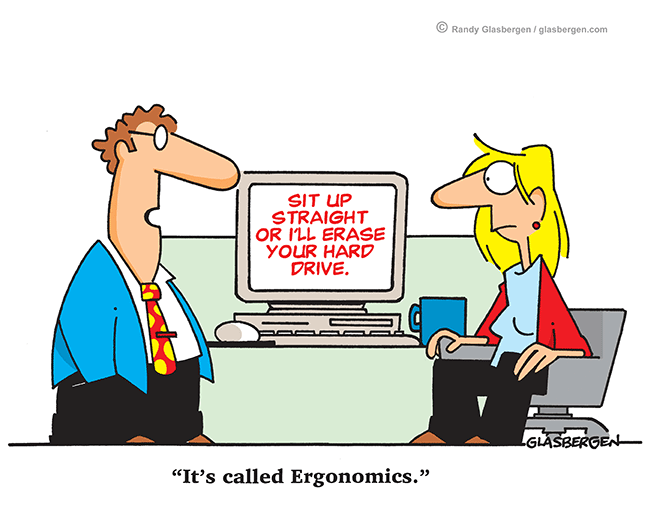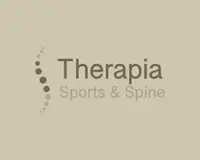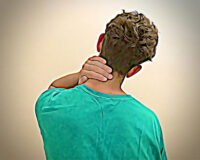
Posture and Exercises for Office Workers
Especially coming into the cooler months, office work pain is something we see a lot of as physiotherapists. The most common injuries/areas of soreness are:
- Headaches
- Mid-back pain
- Lower back pain
- Shoulder pain
- Forearm/wrist pain
Thankfully, most of these issues can be reduced, if not eliminated, by good posture. Good posture occurs when the spine, and body, is aligned. When this happens, every part of the musculoskeletal system will be working as efficiently as possible and no part will be placed under excess stress. You will be able to see good posture when the “Plumb Line”, an imaginary line through your ear, shoulder and hips (in sitting), is straight.
There are many factors that can cause bad postures to develop, including genetics, stress, weight issues, weak muscles, injuries/accidents, reduced activity and poor office setup (just to name a few!).
Unfortunately, the dangers of poor posture, however caused, can be quite debilitating. As mentioned earlier, there are many different areas susceptible to pain caused by poor posture. Without correcting things, and settling into bad habits, these pains can become chronic pains over time (which can make them much harder to treat as they involve changes within the brain).
So, what can we do about it? Alongside keeping your posture aligned (as much as possible) and weight down, here are a few exercises to help:
The “Chin-tuck” Exercise
With your posture upright and shoulders relaxed, tuck your chin in as far as comfortable, and relax. (No need to hold position). You should feel a gentle stretch at the back of your neck.
Repeat 10 times
…………………………………………………….
Neck Stretch
Sit on one hand (or hold it behind back), and gently tilt your head towards other shoulder.
Once in this position, you can try turning towards the shoulder you are tilted towards for an extra stretch along the side of the neck.
Hold 10 seconds. Repeat 2 times.
…………………………………………………….
The Doorway Stretch
Place your forearms along a doorframe and slowly stretch your body through the doorway (easier with one foot in front).
You should feel a stretch in the middle back, and also across the chest muscles. (You may also feel a stretch in the calf muscle of the back leg).
Hold 10 seconds. Repeat 2 times.
…………………………………………………….
Thoracic Rotations
Sit on the side of a chair. Slowly pull yourself into rotation, using the chair’s backrest to help.
You should feel this stretch down the middle of the back, between the shoulder blades.
Hold 5 seconds. Repeat 2 times.
…………………………………………………….
Seated Gluteal Stretch
Sit near the edge of chair and cross one foot over the other knee. Sit up tall and slowly lean forwards (keeping your back straight).
You should feel this stretch in the buttock of the crossed leg.
Hold 10 seconds. Repeat 2 times.
…………………………………………………….
Back Extensions
Place your hands over the top of the pelvis at the back, and slowly lean backwards. Move as far as you feel comfortable. (You can hold this position if comfortable).
Repeat 5 times.
…………………………………………………….
Wrist Stretches
Keep your arm straight, and slowly pull your hand downwards (photo 1).
Hold for 10 seconds. Repeat 2 times (per hand).
Repeat this stretch, but instead pull your fingers back towards you (photo 2).
…………………………………………………….
These stretches should take between 5-10 minutes. We’d recommend taking a 5-10 minute break every hour that you’re sitting in front of the screen. Research has shown that these breaks significantly boost many health markers, and have also been shown to boost long-term productivity at work.
Happy stretching! But remember, if you’re unsure about any exercises, or experience discomfort with any of them, please consult your physiotherapist.
At Therapia, we will specifically design protocols suited to your individual needs. Don’t ignore your posture, flexibility and your core muscles. Book an appointment with one of our physiotherapists for a comprehensive and customized exercise program to help to tone and re-educate those muscles and put you right on track for a healthy posture.
Book Appointment
Sources:
“Global Recommendations on Physical Activity for Health”, World Health Organisation, 2010
National Physical Activity Guidelines for Adults, Australian Government Department of Health and Ageing 2005. (http://www.health.gov.au)
“The Ultimate Guide to Good Posture”, The Greatist Team (Pinterest article), November 28, 2011




